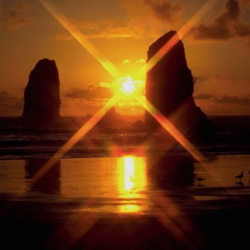 Fanfare for a New-Found Land (Orchestra: 3-2-2-2, 4-3-3-1, 3 perc., 1 timp., str.)
Fanfare for a New-Found Land (Orchestra: 3-2-2-2, 4-3-3-1, 3 perc., 1 timp., str.)
(1997; 5')
Click button to view or download the score (please let me know if you decide to perform this!)
Fanfare for a New-Found Land was composed
in early January of 1997 at the request of Peter Gardner (Newfoundland Symphony Orchestra General & Artistic Director) to commemorate
Newfoundland’s Cabot 500 celebrations.
Giovanni Caboto, whose name has been anglicized to "John Cabot,"
was a Genoan/Venician (other famous Genoans include Christopher Columbus and Niccoló Paganini) navigator who reasoned that,
since Northern (and Southern) latitude lines are shorter than equatorial ones,
a North Atlantic route would be the shortest route to the Far East. He also reasoned (incorrectly) that the source of Far East
spices was Northern Asia. On the basis of these two assumptions, he was able to get a grant in 1496 from King Henry VII of England
to "to seeke out, discover, and finde, whatsoever iles, countreyes, regions or provinces of the heathen and infidelles,
whatsoever they bee, and in what part of the world soever they be, whiche before this time have beene unknowen to all Christians."
His first journey, in 1496, is thought to have reached no farther than Iceland so he tried again the next year, using a single,
relatively small ship called the Matthew with a crew of eighteen. This second voyage was more successful,
and it is generally acknowledged that he reached (and spent a month exploring) a northern location in North America.
There is no consensus as to where this was, unfortunately; it may have been Labrador or
elsewhere in Newfoundland, although many historiographers
argue that it was Nova Scotia or Cape Breton Island, while some suggest it was farther south, in Maine
(read more here, if you wish).
He returned to England apparently thinking he had reached the Far East, but died during a subsequent voyage the following year.
Whether or not Caboto actually "discovered" Newfoundland (what is not in dispute is that the first Europeans
(possibly Leif Eriksson) reached and built a Viking settlement in L'anse Aux Meadows, Newfoundland, 500 years earlier),
the good news for me was that I was commissioned (with the assistance of the Royal Bank of Canada) to compose
a 3 - 5 minute fanfare to mark the 500th anniversary of this possibly-auspicious event, to be used to open every NSO
concert for all of 1997.
A fanfare was traditionally a flourish for trumpets and sometimes percussion, usually of
a celebratory nature, but in the 19th and 20th centuries it was often a longer work that usually
included the trumpet flourishes of the traditional
fanfare. While my fanfare includes some celebratory trumpet flourishes,
the moods shift periodically to represent different characteristics of this province .
I think of it as my short, subjective musical portrait of Newfoundland.
The principal theme is folk-like, given to the violins at the outset, my way of making a reference to the
strong fiddle-music tradition here without quoting any actual folk melodies. This is meant to generate a
sense of excitement, since this is, after all, a concert-opener. The mood in the next section gradually shifts to become more
introspective, suggesting perhaps a sense of longing or even sadness, and I
hope of beauty as well, all qualities I identify strongly with this province.
However, this mood does not last long and soon we move to a more lively and
dramatic character again as the piece works its way to its climactic final
section, which includes a brief reference to the “Ode to Newfoundland.”
©Clark Winslow Ross
Live performance by the Newfoundland Symmphony Orchestra, Marc David, conductor
[If the music doesn't begin playing automatically after a few seconds, click here ]
(My apologies for the poor recording quality)